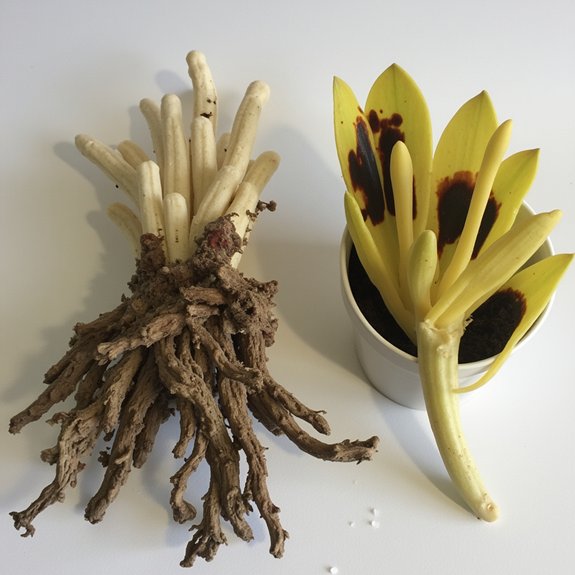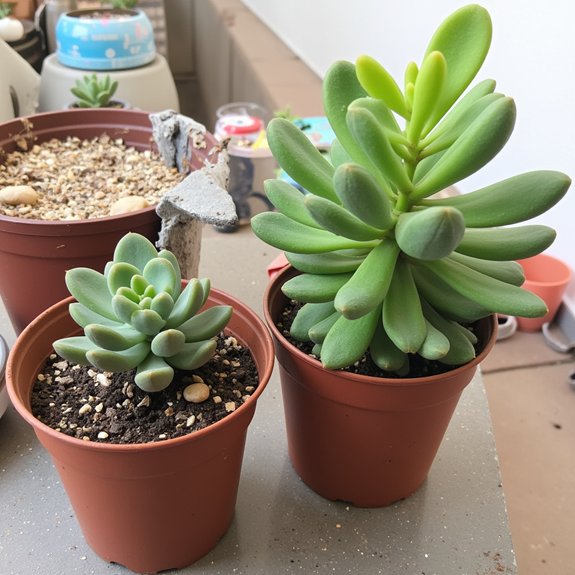Most gardeners notice their succulents looking sad, wrinkled, or mushy before realizing something’s wrong. These resilient plants can bounce back from near-death experiences, but only if you identify the real problem first. Common culprits include waterlogged soil, insufficient drainage, or surprisingly, too little light exposure. The key lies in understanding that different symptoms require completely different solutions, and applying the wrong fix can push your plant past the point of recovery.
Contents
- 1 Identifying Signs of Overwatering and Root Rot
- 2 Creating the Perfect Drainage System for Your Succulents
- 3 Recognizing and Treating Underwatered Plants
- 4 Finding the Right Balance of Light and Sun Exposure
- 5 Protecting Your Plants From Temperature Stress
- 6 Dealing With Common Pest Infestations
- 7 Choosing the Right Container Size and Setup
- 8 Improving Air Circulation Around Your Plants
- 9 Understanding Normal Aging vs. Health Problems
- 10 Proper Watering Techniques to Prevent Crown Rot
Identifying Signs of Overwatering and Root Rot

Why do succulent leaves turn yellow and mushy when everything seemed fine just weeks before? The answer usually lies in overwatering symptoms that develop gradually, then strike suddenly. Yellowing leaves, especially those turning soft and translucent, signal excess moisture damage.
Mushy leaves that pull off easily indicate serious trouble brewing below the surface. Brown or black spots often accompany this decline, creating an unmistakable pattern of distress. Healthy roots should appear white or pale yellow, while rotted roots turn dark brown or black.
Root rot prevention starts with recognizing these early warning signs before permanent damage occurs.
Creating the Perfect Drainage System for Your Succulents
Once overwatering damage becomes evident, the solution lies in rebuilding the foundation that keeps succulents thriving. Proper drainage materials form the backbone of healthy succulent care, preventing future water-related disasters.
Start with specialized succulent potting mix, which drains faster than standard soil. Add perlite or coarse sand at a 1:1 ratio to improve texture further. For containers, guarantee drainage holes exist in every pot, regardless of size.
Effective drainage techniques include layering materials strategically. Place small stones or gravel at the bottom, followed by the amended soil mixture. This creates pathways for excess water to escape quickly, mimicking natural desert conditions.
Recognizing and Treating Underwatered Plants

How can gardeners distinguish between thirsty succulents and their overwatered counterparts? Underwatering symptoms include leaves that wrinkle, wilt, and dry out, typically starting on upper leaves before progressing downward. Unlike overwatering, these leaves feel firm rather than mushy.
Recovery tips involve watering thoroughly once soil feels completely dry. Check soil moisture every two weeks by inserting a finger one inch deep. Water should flow through drainage holes, ensuring proper penetration without creating soggy conditions.
Recovery requires patience, often taking one to two months with consistent care. Remove completely dried leaves, but avoid excessive handling during the healing process.
Finding the Right Balance of Light and Sun Exposure
Where does proper lighting fit into the succulent care equation? These plants demand at least six hours of daily sunlight to maintain their compact shape and vibrant colors. However, understanding light requirements means recognizing that too much direct sun exposure can scorch leaves, creating permanent brown spots and damage.
Inadequate lighting causes etiolation, where succulents stretch toward available light sources, resulting in leggy growth and pale coloration. If this occurs, cut the top portion and replant in a brighter location. Balance remains key: provide sufficient brightness while protecting from intense afternoon rays.
Protecting Your Plants From Temperature Stress

While succulents tolerate various conditions, sudden temperature fluctuations create stress that weakens these hardy plants and triggers a cascade of health problems. The ideal range sits between 60°F and 80°F, with gradual changes being key to healthy growth. Temperature fluctuations cause yellowing, browning leaves, and potential root rot when combined with cold exposure.
Seasonal care requires adjusting plant placement as weather shifts. Move outdoor succulents to protected areas before frost arrives, and gradually shift indoor plants when relocating them outside. During extreme heat waves, provide afternoon shade to prevent heat stress. Monitor local weather forecasts to anticipate dramatic temperature swings.
Dealing With Common Pest Infestations
Even healthy succulents can fall victim to persistent pests that quietly infiltrate gardens and windowsills, feeding on plant juices and multiplying rapidly when conditions favor their survival. Aphids, mealybugs, spider mites, and snails represent the most common invaders, puncturing leaves and stems while potentially spreading to nearby plants.
Effective pest prevention starts with regular weekly inspections, checking leaf undersides and stem joints where bugs typically hide. Treatment methods include spraying affected areas with soapy water, insecticidal soap, or neem oil applications every 3-5 days until elimination occurs. Quarantine infected plants immediately to prevent spread throughout collections.
Choosing the Right Container Size and Setup
Container selection greatly influences succulent health, as oversized pots create moisture traps that lead to root rot and plant death. Choose containers slightly larger than the root system, typically 1-2 inches wider than the plant’s base. Drainage holes remain non-negotiable for preventing water accumulation.
Container materials matter greatly for plant success. Terra cotta pots provide excellent breathability, allowing soil to dry faster between waterings. Plastic containers retain moisture longer, requiring adjusted watering schedules.
Proper potting techniques include filling containers with specialized succulent soil mix, leaving space between soil surface and rim for watering, and ensuring adequate spacing between multiple plants for airflow.
Improving Air Circulation Around Your Plants
Good air circulation prevents the stagnant conditions that encourage mold, fungal infections, and pest infestations in succulent collections. Proper succulent spacing allows air to move freely between plants, reducing moisture buildup that leads to rot. Place containers at least 2-3 inches apart, avoiding overcrowded arrangements that trap humid air.
Effective airflow techniques include positioning plants near open windows, using small fans on low settings, or relocating collections to breezy outdoor areas. Indoor growers should rotate plants weekly to guarantee all sides receive adequate ventilation. These simple adjustments create the dry, moving air that mimics succulents’ natural desert environments.
Understanding Normal Aging vs. Health Problems
As succulents mature, distinguishing between natural aging processes and genuine health concerns becomes essential for proper plant care. Normal aging includes the gradual shedding of lower leaves, particularly in rosette varieties, which creates space for new growth from the center. These dying leaves naturally turn brown and shrivel, making room for fresh development.
Health problems, however, present differently. Watch for sudden yellowing across multiple leaves, mushy textures, foul odors, or widespread discoloration. These symptoms indicate overwatering, poor drainage, or disease rather than normal aging. Remove naturally withered leaves to prevent pest issues, but address health problems through proper care adjustments.
Proper Watering Techniques to Prevent Crown Rot
When watering succulents, directing water exclusively onto the soil rather than the plant itself prevents the deadly crown rot that kills more succulents than drought ever could. Use a thin-stemmed watering can to target soil directly, avoiding leaves and plant centers where water pools dangerously.
Water frequency depends on accurate moisture measurement using the finger test. Insert your finger two inches deep into soil; water only when completely dry. This typically means watering every two weeks during growing season, less in winter. Remove any standing water from saucers within thirty minutes to prevent root rot development.
